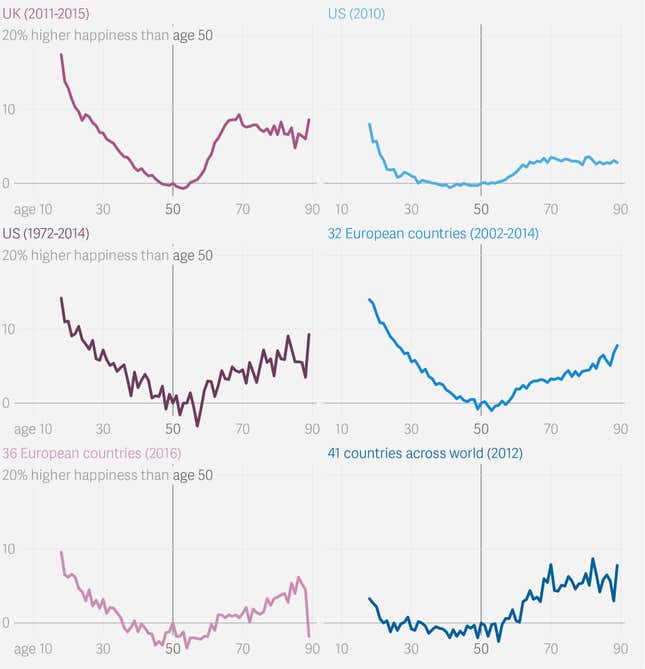Life starts well, and ends well. The middle often stinks.
This is, crudely put, the finding of a recently released paper (paywall) from economists David Blanchflower of Dartmouth College and Andrew Oswald of the University of Warwick. Their study analyzed the responses to questions about life satisfaction, by age, from seven datasets from across the world. They consistently found evidence of a “midlife dip.”
The typical pattern: Average life satisfaction slowly declines from early adulthood high until reaching rock bottom in the 40s or early 50s, depending on the dataset. From that low point, life satisfaction rises through the late 50s, 60s and 70s,—only to fall or plateau again when people reach their 80s.
The researchers note there are two ways to consider the impact of age on happiness:
- Look at the raw relationship of age to life satisfaction, without trying to account for differences like income or marital status. This answers the question, “Is the average 50 year old happier than the average 40 year old?”
- Try to find the specific causal effect of age after accounting for other factors. This answers the question, “Is a 50 year old person happier than a 40 year old with the same income, marital status, number of kids, etc.?”
Blanchflower and Oswald attempted to answer both questions. For the seven datasets they analyzed, they found a “raw” midlife dip in five of the seven, and a midlife dip in all seven after accounting for other factors. The following chart shows the results for the latter (data for six of the surveys were provided by the researchers).

Blanchflower and Oswald counter that the pattern appears to be robust across many countries where the historical circumstances have been vastly different. They reject the idea that it is simply a generational effect. And the researchers don’t offer further explanation of their main finding. Their only goal was simply to offer evidence that life satisfaction over time is U-shaped.
One interesting theory for the late rise in happiness, suggested by Stanford University psychology professor Laura Carstensen in The Economist, is that older people are better at living in the moment. With mortality on the horizon, people are less likely to make decisions that are painful in the short-term, for long-term gain.
